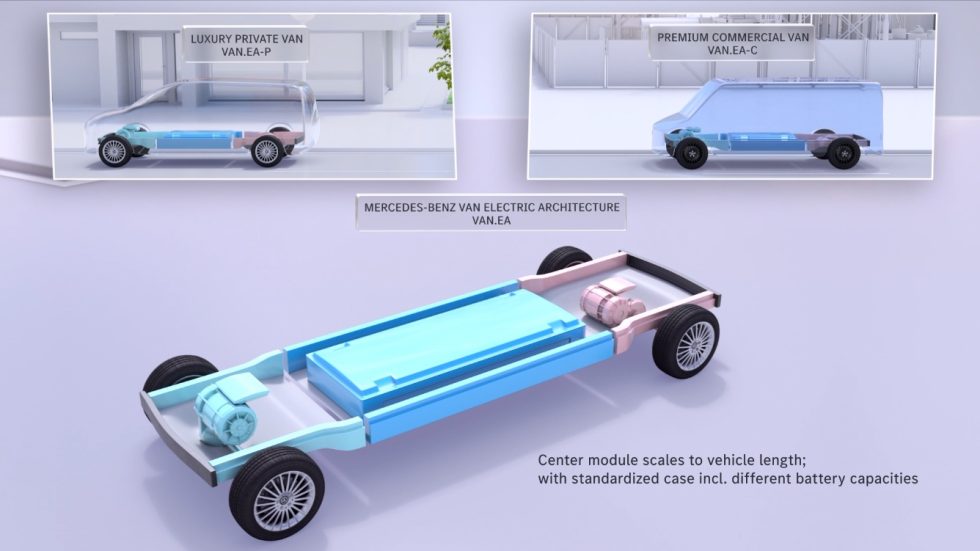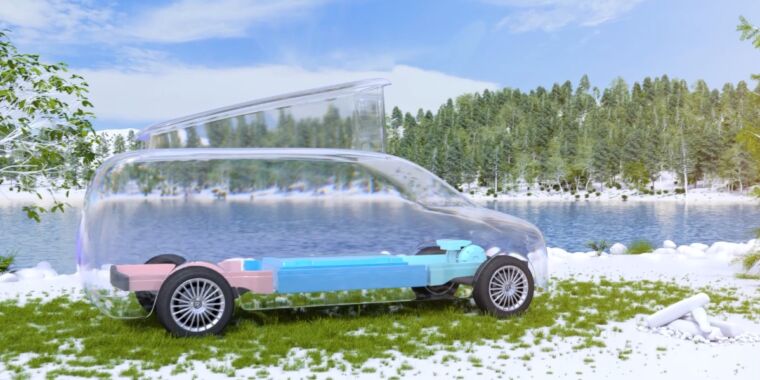
Mercedes-Benz
Mercedes-Benz Vans is on the verge of launching its next big thing. On Tuesday, the luxury carmaker’s Vans division detailed a new fully scalable electric vehicle architecture, called Van.EA, which is expected to bear fruit in 2026. From midsize luxury vans to full-size cargo and camper vans, Mercedes-Benz says Van.EA will provide extremely versatile bones.
“We will merge our midsize and large vans onto one platform,” Mathias Geisen, head of Mercedes-Benz Vans, told reporters during a press conference on Monday. “That wasn’t possible in the past.”
How will that work? Basically, Van.EA will consist of three main parts. Up front, a common axle and electric drive unit will be shared across all Van.EA vehicles. The middle section will be the most flexible, with different lengths and battery sizes depending on the type of van. Finally, two rear-end options will be offered: one with an electric drive motor, for a dual-motor, all-wheel-drive setup, and one without this extra power unit, for front-wheel-drive vehicles.

Mercedes-Benz
New luxury vans for the US, China, and more
Van.EA will, of course, spawn useful cargo and passenger vans to meet the demands of current Metris and Sprinter customers, but this electric platform will also allow Mercedes-Benz to explore new types of vans tailored to specific markets. In the US, Mercedes-Benz will use the midsize version of this architecture for what it calls Van.EA-P, where the “P” stands for “private,” or perhaps “passengers.” These will be luxury-minded vans designed for families, or to be used as high-end shuttles.
Don’t think of this as a replacement for the Metris, by the way; “that’s clearly a commercial vehicle,” Geisen said. “The van we will launch based on the Van.EA platform will have an absolute focus on luxury [and] has nothing to do with a Metris, has nothing to do with a commercial application.”
“We’re completely free when it comes to styling, when it comes to the interior and exterior design, when it comes to autonomous features,” Geisen said. “It will have the latest and greatest available.”
On that note, Mercedes-Benz says we can expect Van.EA-P to launch with Level 2 driver-assistance functionality—basically, what the company offers in its passenger cars today—with Level 3 capabilities coming by the end of the decade. No battery sizes or power figures are available right now, but Van.EA-P has “a planned range of well over 500 kilometers (~310 miles),” Mercedes-Benz said in a statement.
Purpose-built camper vans won’t compromise third-party upfitters
In addition to private luxury vehicles, Mercedes-Benz will also expand Van.EA to include purpose-built camper vans, but will do so in a way that doesn’t compromise the relationship the company currently has with its third-party upfitters.
“It’s nothing very special we’re doing,” Geisen said, pointing to the European Marco Polo van—a camper based on a midsize van that briefly came to the US as the Metris Getaway.
“We build this vehicle in our factory, and still we have lots and lots of upfitters doing their upfitting work,” Geisen said. “We will never be able to cover the whole range of RVs.”
But what about the Sprinter?
Mercedes-Benz knows that a fully electric van will not work for all its customers, and because of this, “the combustion engine Sprinter will stay in the market throughout the whole decade,” Geisen said. “It’s absolutely clear that [the Sprinter] will be in the market in parallel to the electric van. We will build it as long as there is demand.”
The eSprinter, which will come to the US later this year, will “be replaced by the successor on Van.EA,” Geisen said. “We will not have an eSprinter and a Van.EA eSprinter in parallel. One will follow in succession of the other.”
Like the Sprinters, large Van.EA models will be built in Dusseldorf, Germany, while midsize versions will go into production in Vitoria, Spain. Mercedes-Benz is also planning to build Van.EA vehicles at its dedicated van plant in Charleston, South Carolina, but it’s unclear when that shift will occur.
“We have pretty clear plans [as to] when and how to do that, but we haven’t finalized all negotiations yet,” Geisen said. But since US market expansion is a key objective with the launch of Van.EA, Geisen said it would be silly not to make Charleston a priority production site.
“The US is one of our core world markets,” he said.








